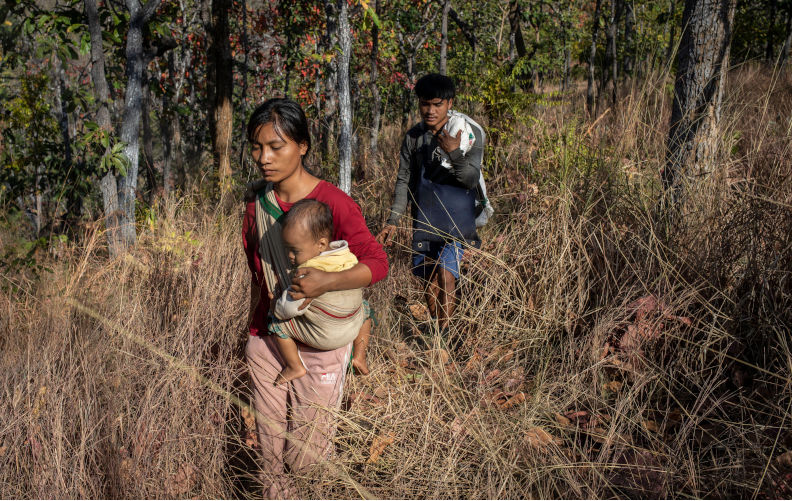Paper walls at Thailand’s border
October 18, 2025
Myanmar’s current emergency is not a sudden rupture but a long arc of military rule that has criminalised dissent, dismantled civil society and pushed millions into precarity.
Australia’s own DFAT Country Information Report (April 2025) charts the risks faced by people associated with the Civil Disobedience Movement, the expanding enforcement of conscription and the routine use of arbitrary arrest and ill-treatment. These are not passing conditions. They are structural realities that endure year to year.
Thailand’s legal vacuum
Many who flee Myanmar cross into Thailand. Yet Thailand is not a party to the 1951 Refugee Convention or the 1967 Protocol. In practice, this leaves most border-zone families outside any formal protection regime, often without lawful status and at constant risk of checks, detention or removal. Recent rights reporting documents frequent police stops, extortion and uncertainty for undocumented Myanmar nationals living in towns like Mae Sot.
Australia’s program settings
Australia rightly maintains an offshore Refugee and Humanitarian program that resettles people who cannot remain where they are. The current planning level is 20,000 places for 2024–25 but, in practice, this number is never enough. On paper, the pathways are clear: the offshore Class XB stream spans the Refugee category visas and the Global Special Humanitarian visa, with published criteria and guidance. In practice, for Myanmar families in Thailand, the steps between a lodged application and a decision are where the system becomes opaque.
A family in limbo
Consider one Melbourne case that illustrates the problem. As a teenager, a woman we will call A left Myanmar and rebuilt her life in Australia. She is now a citizen, a community volunteer and a worker in a Victorian primary school. Her parents and younger brothers fled to Mae Sot in October 2022 after political involvement made life untenable. They have no lawful status, live with daily risk and cannot plan schooling or consistent access to healthcare. With Australian friends and community groups ready to support settlement in Coffs Harbour, a complete humanitarian application was lodged in November 2024. Months later, the family remains in limbo.
This is not a plea for special treatment. It is a call for a transparent process that recognises protection risks, tests claim in a timely way and allows Australian communities to do the welcoming they have already organised.
Where files stall
From the outside, the chokepoints are predictable and avoidable. Proving identity is difficult where documents have been lost or never issued. Biometrics and medicals rely on third-party providers with limited capacity in border regions. Exit permits are uncertain for people who are undocumented. None of this is a surprise to decision-makers. What compounds the harm is the absence of a clear, published escalation pathway for urgent cases in Thailand. When families have acute protection or medical risks, there is no transparent route for a protection-sensitive review by an officer trained to weigh urgency. The result is a system that defaults to silence.
Policy versus practice
A capped program is not, by itself, the cause of suffering. The problem is how that cap interacts with opaque triage and outsourced steps. For children and young adults, every lost term out of school has lifelong effects. For older parents, prolonged uncertainty worsens chronic illness and increases the risk of arrest or removal. For the Australian communities waiting to support them, months of silence erodes trust in the system. Australia’s stated commitments count for little if the practical journey is a maze without signposts.
What would help
- Publish an escalation channel. When risk factors are acute, there should be a documented way to request review by an officer trained in protection-sensitive triage for Thai-based Myanmar cases.
- Explain triage plainly. A short public note on factors that affect prioritisation would reduce guesswork and misinformation for applicants and their Australian supporters.
- Map third-party steps. Clear guidance for Thailand on biometrics, medicals and exit permits would let families prepare efficiently and set expectations about timelines and costs.
- Report timelines. Even indicative end-to-end time bands for lodgements from Thailand would help communities plan interim care, schooling and health support.
- Leverage community readiness. Where an Australian community can demonstrate settlement capacity, that should weigh in favour of timely decision-making.
Australia’s responsibility
Australia’s refugee policy often invokes “orderly” and “safe” pathways. Those words need substance at the coalface. Class XB exists to move people from danger to safety through a rules-based process. If the rules are not intelligible, or if there is no visible way to elevate urgent files, then the system fails the very people it is designed to protect. Australia does not control Thailand’s legal framework, and it cannot fix Myanmar’s politics, but it can control its own transparency and timeliness.
The choice before us
A is an Australian. Her parents and brothers are not abstractions. They are people who could be at her dinner table next month if an already lodged case were processed and decided. Publishing an escalation pathway does not guarantee a grant. It guarantees that urgent risks are seen by someone with the authority to act. That is the least a humane, rules-based program should promise.
Australia can keep building paper walls or it can clear a path that is safe, orderly and human. The choice is ours.
Disclaimer: This article is based on a real, de-identified case, with details changed to protect the family’s safety. The author, Ko Ko Aung, is the family’s lawyer.
The views expressed in this article may or may not reflect those of Pearls and Irritations.
